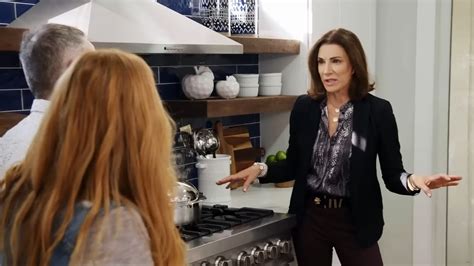
Hilary Farr, renowned designer and star of HGTV’s “Tough Love,” advocates for strategically using decorative elements, specifically large, eye-catching bowls, to camouflage kitchen clutter during open houses, creating an illusion of spaciousness and order for potential buyers.
TORONTO – For homeowners preparing to sell, the challenge of staging a home for open houses often includes the daunting task of decluttering. Hilary Farr, the celebrated designer known for her no-nonsense approach on HGTV’s “Tough Love,” offers a surprisingly simple yet effective solution: artful camouflage. Instead of banishing every countertop appliance and utensil to storage, Farr suggests strategically using large, decorative bowls to contain and conceal everyday kitchen clutter. This approach not only creates a visually appealing aesthetic but also suggests a sense of organized, livable space, crucial for attracting potential buyers.
Farr emphasizes that the goal is not to completely sterilize the kitchen but rather to create an inviting atmosphere. “Buyers need to envision themselves living in the space,” Farr explains. “Completely empty countertops can feel sterile and unwelcoming. A few carefully curated items, strategically placed, can make all the difference.”
The key to Farr’s method lies in the selection of the bowls themselves. She recommends opting for statement pieces that complement the kitchen’s overall design. “Think texture, color, and scale,” Farr advises. “A large wooden bowl filled with lemons or limes can add a pop of color and freshness, while a woven basket can conceal less attractive items like keys or mail.” The bowls should be large enough to hold a significant amount of clutter but not so large that they overwhelm the countertop.
The placement of these clutter-concealing bowls is equally important. Farr suggests focusing on areas that tend to accumulate the most clutter, such as the island, the peninsula, or the space next to the stove. “These are the areas that buyers will naturally focus on,” Farr notes. “By strategically placing bowls in these locations, you can instantly create a sense of order and calm.”
Beyond aesthetics, Farr’s approach also acknowledges the practical realities of daily life. Potential buyers understand that kitchens are functional spaces, and seeing a few carefully chosen items on the countertops can actually make the space feel more relatable and livable. “It’s about striking a balance between showing off the kitchen’s features and creating a space that feels like home,” Farr explains.
This decluttering strategy is part of Farr’s broader philosophy of home staging, which emphasizes creating an emotional connection with potential buyers. “People buy with their hearts, not just their heads,” Farr says. “By creating a space that feels warm, inviting, and livable, you’re more likely to capture their attention and ultimately, secure a sale.”
The bowl technique isn’t just about hiding mess; it’s about creating vignettes. Imagine a gleaming stainless steel bowl filled with vibrant green apples, reflecting the light and adding a touch of life to the kitchen. Or a rustic earthenware bowl holding wooden spoons and utensils, suggesting a cozy, functional cooking space. These carefully curated displays can elevate the entire kitchen aesthetic, transforming it from a purely utilitarian space into a stylish and inviting heart of the home.
Furthermore, Farr’s suggestion cleverly addresses a common anxiety for homeowners preparing for open houses: the need to maintain a spotless environment while still living in the space. It offers a practical, manageable solution that doesn’t require extreme measures like packing away all personal belongings. It’s about presenting a version of everyday life that is both appealing and attainable.
The effectiveness of Farr’s strategy extends beyond visual appeal. By containing clutter within designated bowls, homeowners can more easily maintain a tidy appearance throughout the open house. A quick sweep of the countertops and a strategic rearrangement of the items within the bowls can instantly refresh the space between showings. This ease of maintenance is a significant advantage, especially when juggling the demands of daily life with the pressures of selling a home.
Moreover, the use of decorative bowls can serve as a subtle form of branding for the home. By choosing bowls that reflect the overall style and character of the house, homeowners can reinforce the desired image and create a cohesive aesthetic. A modern, minimalist kitchen might feature sleek glass bowls, while a farmhouse-style kitchen could incorporate rustic wooden bowls or woven baskets.
The impact of a well-staged kitchen on potential buyers cannot be overstated. Studies have shown that kitchens are one of the most important rooms in the house for prospective homeowners, often influencing their overall impression of the property. A clean, organized, and inviting kitchen can significantly increase the perceived value of the home and make it more appealing to a wider range of buyers.
In conclusion, Hilary Farr’s clever kitchen clutter camouflage technique offers a simple yet effective way to enhance the appeal of a home during open houses. By strategically using decorative bowls to contain and conceal everyday items, homeowners can create a visually appealing, organized, and inviting space that resonates with potential buyers. This approach not only simplifies the staging process but also helps to create an emotional connection that can ultimately lead to a successful sale. It’s about transforming a potentially stressful process into an opportunity to showcase the home’s best features and create a lasting positive impression.
Expanded Analysis and Context:
Hilary Farr’s advice resonates deeply within the context of contemporary real estate and interior design trends. Today’s buyers are not simply looking for a house; they are seeking a lifestyle. This shift has placed increased emphasis on the importance of home staging, transforming it from a simple act of tidying up into a sophisticated art form. Farr’s technique caters directly to this trend, offering a practical and aesthetically pleasing solution to the common challenge of kitchen clutter.
The concept of “lifestyle buying” is particularly relevant in today’s market. Potential buyers are often drawn to homes that reflect their values, aspirations, and personal style. A well-staged kitchen can play a crucial role in conveying the desired lifestyle. By carefully curating the items displayed on the countertops, homeowners can create a narrative that resonates with potential buyers and helps them envision themselves living in the space.
Farr’s emphasis on creating an emotional connection aligns with the principles of behavioral economics, which suggest that people’s decisions are often driven by emotions rather than purely rational considerations. By creating a warm, inviting, and livable kitchen, homeowners can tap into the emotional drivers that influence buying decisions.
The strategic use of decorative bowls also addresses the psychological principle of “visual framing.” By containing clutter within designated areas, homeowners can create a sense of order and control, making the kitchen appear larger and more spacious. This visual framing can significantly impact the perception of the space and make it more appealing to potential buyers.
Furthermore, Farr’s advice acknowledges the growing importance of sustainability in home design. By suggesting the use of natural materials like wood and woven baskets, she encourages homeowners to incorporate eco-friendly elements into their staging efforts. This aligns with the increasing demand for sustainable homes and appeals to environmentally conscious buyers.
The effectiveness of Farr’s technique is also supported by research in the field of visual merchandising. Studies have shown that strategic placement of objects can significantly influence consumer behavior. By carefully positioning decorative bowls in high-traffic areas, homeowners can draw attention to specific features of the kitchen and create a more engaging and memorable experience for potential buyers.
In addition to the practical benefits of decluttering, Farr’s technique also offers a psychological advantage. Selling a home can be a stressful and emotional process. By taking control of the staging process and implementing simple yet effective strategies like clutter camouflage, homeowners can regain a sense of control and reduce their anxiety.
The use of decorative bowls is also a cost-effective staging solution. Unlike expensive renovations or furniture upgrades, purchasing a few stylish bowls is a relatively inexpensive way to enhance the appeal of the kitchen. This makes Farr’s advice accessible to a wide range of homeowners, regardless of their budget.
Moreover, Farr’s approach is highly adaptable to different kitchen styles and layouts. Whether the kitchen is modern, traditional, or somewhere in between, the basic principles of clutter camouflage can be applied to create a visually appealing and organized space. This versatility makes Farr’s advice relevant to a diverse range of homeowners.
The success of Farr’s technique is also dependent on the overall condition of the kitchen. While decorative bowls can effectively conceal clutter, they cannot compensate for underlying issues like outdated appliances, damaged countertops, or poor lighting. It is important for homeowners to address these issues before implementing the clutter camouflage strategy.
In addition to using decorative bowls, Farr also recommends paying attention to other details in the kitchen, such as the lighting, the paint color, and the hardware. These seemingly minor details can have a significant impact on the overall impression of the space. By carefully curating these elements, homeowners can create a cohesive and visually appealing kitchen that resonates with potential buyers.
Ultimately, Hilary Farr’s clever kitchen clutter camouflage technique offers a practical, cost-effective, and aesthetically pleasing solution to the common challenge of home staging. By strategically using decorative bowls to contain and conceal everyday items, homeowners can create a visually appealing, organized, and inviting space that resonates with potential buyers and helps them envision themselves living in the space. This approach not only simplifies the staging process but also helps to create an emotional connection that can ultimately lead to a successful sale. It’s about transforming a potentially stressful process into an opportunity to showcase the home’s best features and create a lasting positive impression. It’s a strategy that speaks to both the aesthetic sensibilities of potential buyers and the practical needs of sellers navigating a competitive market.
FAQs:
1. What exactly is Hilary Farr’s clutter camouflage technique?
Hilary Farr’s clutter camouflage technique involves strategically using decorative bowls and containers to conceal everyday kitchen clutter during home staging. Instead of removing all items from countertops, Farr suggests using aesthetically pleasing bowls to contain and organize frequently used items, creating a more inviting and visually appealing space for potential buyers. This technique aims to strike a balance between a sterile, empty look and a cluttered, disorganized one.
2. Why is it important to camouflage clutter when staging a home for sale?
Camouflaging clutter is crucial because it allows potential buyers to envision themselves living in the space without being distracted by personal belongings. A decluttered and organized kitchen gives the impression of spaciousness and order, which can positively influence buyers’ perception of the home’s value. It creates a more welcoming and appealing environment, helping buyers connect emotionally with the property.
3. What types of bowls and containers are best for clutter camouflage?
Hilary Farr recommends selecting statement pieces that complement the kitchen’s overall design. Consider texture, color, and scale. Examples include large wooden bowls for fruits, woven baskets for mail or keys, and sleek stainless steel bowls for utensils. The bowls should be large enough to hold a significant amount of clutter but not so large that they overwhelm the countertop.
4. Where should I place these clutter-concealing bowls in my kitchen?
Focus on areas that tend to accumulate the most clutter, such as the kitchen island, peninsula, or the space next to the stove. These are high-traffic areas that buyers will naturally focus on. Strategically placing bowls in these locations can instantly create a sense of order and calm. You can also place bowls near the sink to collect dishwashing supplies.
5. Is it necessary to completely empty my kitchen countertops for an open house?
No, Hilary Farr advises against completely emptying countertops, as this can create a sterile and unwelcoming atmosphere. Instead, focus on carefully curating a few essential items and strategically placing them in decorative bowls. The goal is to create a balance between showcasing the kitchen’s features and creating a space that feels like home. Potential buyers need to see a lived-in but organized space.
6. Can this technique work for any kitchen style?
Yes, the clutter camouflage technique is adaptable to various kitchen styles. The key is to choose bowls and containers that complement the overall aesthetic. For a modern kitchen, opt for sleek glass or metal bowls. For a farmhouse-style kitchen, consider rustic wooden bowls or woven baskets. Adapt the materials and designs to match the existing decor.
7. How does clutter camouflage help to create an emotional connection with potential buyers?
By creating a warm, inviting, and livable space, clutter camouflage helps potential buyers connect emotionally with the home. A well-staged kitchen allows buyers to envision themselves cooking, entertaining, and creating memories in the space. This emotional connection can significantly influence their decision to make an offer on the property. Hilary Farr believes that people buy with their hearts, not just their heads.
8. Is this clutter camouflage technique an expensive way to stage my kitchen?
No, using decorative bowls and containers is a cost-effective way to stage your kitchen. Unlike expensive renovations or furniture upgrades, purchasing a few stylish bowls is a relatively inexpensive investment that can significantly enhance the appeal of the space. You can find affordable options at home goods stores, thrift shops, or online retailers.
9. Besides using decorative bowls, what other tips does Hilary Farr recommend for staging a kitchen?
In addition to clutter camouflage, Hilary Farr recommends paying attention to other details in the kitchen, such as lighting, paint color, and hardware. Ensure that the kitchen is well-lit, clean, and free of any unpleasant odors. Consider updating outdated hardware or repainting the walls in a neutral color. A fresh coat of paint can make a big difference.
10. How can I maintain the clutter-camouflaged look during an open house?
To maintain the look during an open house, periodically tidy the countertops and rearrange the items within the bowls. Before each showing, quickly sweep the surfaces and ensure that the bowls are neatly arranged. This will help to create a consistently organized and appealing space for potential buyers. It’s about maintaining a level of organization throughout the showing period.
11. Does this technique only apply to kitchens, or can it be used in other areas of the house?
While the article focuses on kitchens, the principle of using decorative containers to manage clutter can be applied to other areas of the house. Living rooms, bathrooms, and bedrooms can all benefit from strategically placed baskets, trays, and boxes to contain and organize everyday items. The key is to choose containers that complement the room’s style and create a cohesive look.
12. What should I do with the clutter that I remove from the countertops before placing it in the decorative bowls?
Designate a temporary storage area for the clutter that you remove from the countertops. This could be a closet, a spare room, or even a storage container in the garage. The goal is to keep the clutter out of sight during the open house. After the showing, you can return the items to their original locations or decide whether to permanently declutter them.
13. How can I incorporate seasonal elements into my clutter camouflage strategy?
You can incorporate seasonal elements by changing the items displayed in the decorative bowls. For example, during the fall, you could fill a wooden bowl with pumpkins or gourds. During the winter, you could display pinecones or ornaments. This adds a festive touch to the kitchen and helps to create a warm and inviting atmosphere. Just ensure the elements still align with the overall design aesthetic.
14. Is it necessary to hire a professional home stager to implement this technique?
No, hiring a professional home stager is not necessary. The clutter camouflage technique is simple enough for homeowners to implement themselves. By following Hilary Farr’s advice and using a little creativity, you can effectively stage your kitchen without breaking the bank. However, if you are unsure about your staging skills or lack the time to do it yourself, hiring a professional stager may be a worthwhile investment.
15. What are some common mistakes to avoid when using the clutter camouflage technique?
Some common mistakes to avoid include using bowls that are too small to hold the clutter, choosing bowls that clash with the kitchen’s decor, and overfilling the bowls with too many items. It’s also important to ensure that the bowls are clean and well-maintained. Avoid using cracked, chipped, or stained bowls, as this can detract from the overall appearance of the kitchen. Clutter camouflage should appear intentional and stylish, not haphazard.









